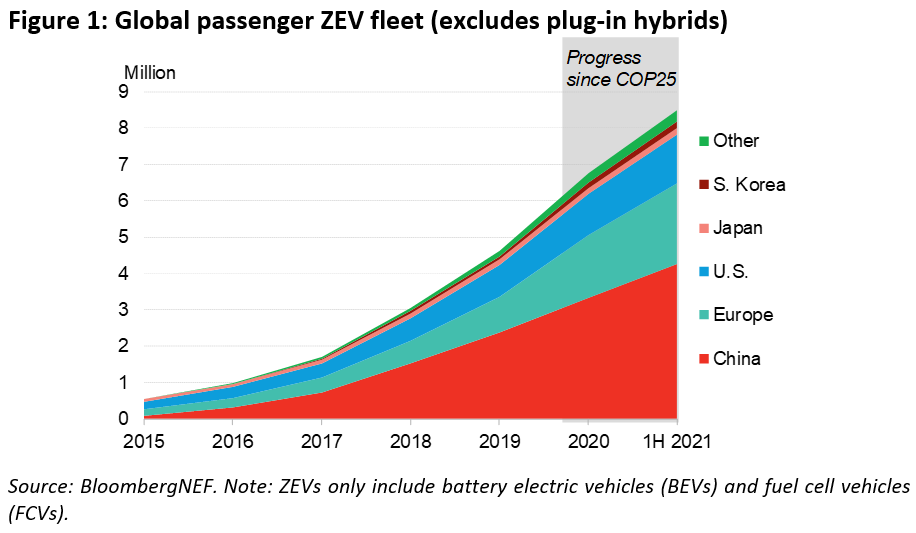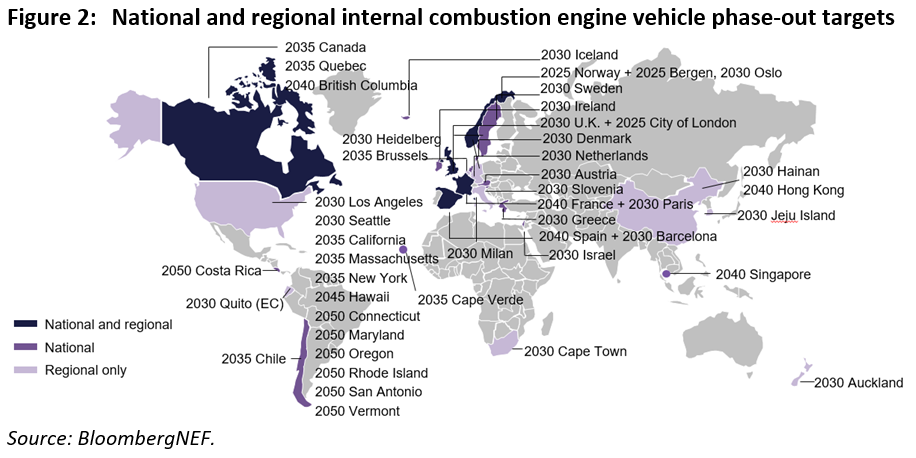32% of global auto market now covered by manufacturers’ commitments to end sales of fossil fuel-powered vehicles, and 20% covered by equivalent national policies
London, United Kingdom– Passenger electric vehicle sales are set to jump over 80% in 2021, to 5.6 million units, off the back of unprecedented industry and government commitments around the world over the last two years, according to the Zero-Emission Vehicles Factbook, a special report published today by BloombergNEF (BNEF), at the request of the U.K. COP26 Presidency and in partnership with Bloomberg Philanthropies.
The Factbook documents the progress that has been made towards global net-zero emissions in the road transport sector, and shows that the future is brighter than ever for zero-emission vehicles. In the first half of 2021, sales of passenger electric vehicles (including battery electric, plug-in hybrid and fuel cell vehicles) were 140% higher than the same period in 2019, reaching 7% of global passenger vehicle sales. This compares with just 2.6% in 2019, the year of the last UN Climate Change Conference.
The total global fleet of passenger electric and fuel cell vehicles now totals nearly 13 million, of which 8.5 million are true zero-emission vehicles (ZEVs), either battery electric or fuel cell (still, fuel cell vehicles account for a fraction of that total). The latter figure is up from just 4.6 million at the time of COP25. At the same time, by 1H 2021, the global fleet of zero-emission buses has increased by 22% since 2019, and we expect 18% of all municipal buses on the road to be zero-emission at the end of 2021.

What is more, the future looks brighter than ever. A review of industry outlooks shows that zero-emission vehicle forecasts have been raised across the board. BNEF’s own forecast for the global ZEV fleet in 2040 has been raised from 495 million vehicles in its 2019 forecast, to 677 million in its 2021 Electric Vehicle Outlook. The International Energy Agency (IEA) has raised its 2030 battery electric vehicle fleet forecast by 7% since 2019, while the Organization of the Petroleum Exporting Countries (OPEC) has raised its 2040 estimate for the global electric and fuel cell vehicle fleet by 11%.
Underpinning these stronger forecasts are a range of factors, including improving battery technology and costs, faster roll-outs of charging infrastructure, a wider range of vehicle models on offer to customers, and longer range and faster charging speeds available on the newest vehicles. Each of these factors is discussed in detail in the report.
Industry and government commitments
The report is launched in time for Transport Day of COP26, where a coalition of government and global car industry leaders working towards 100% zero-emission new car, van and HGV sales by 2040, will come together, helping to keep 1.5 degrees within reach.
U.K. Transport Secretary Grant Shapps said: “Accelerating towards a greener future is the U.K.’s key priority and I am delighted to see our tremendous efforts towards greening transport reflected in this report. Decarbonising transport is key to conserving our planet and creating new U.K. jobs. Today marks a very proud moment in history as Governments around the world come together behind 100% zero emission car, van and HGV sales by 2040.”
In an Annex to the report, BNEF finds that today’s declaration, in combination with existing commitments, means that automakers committed to reaching 100% zero-emission vehicle sales by 2035 at the latest now account for 32% of the global auto market. The Annex finds that similar national targets account for 20% of passenger vehicle sales.
U.S. state-level targets to phase out sales of internal combustion engines now cover a quarter of auto sales in the country (which currently does not have a national phase-out target). Additionally, the combined national targets, ICE phase-out targets and interim ZEV sales targets of China, India, and the U.S., reach nearly 41% of the global passenger vehicle market. This is up from just 8% in 2019.

Aleksandra O’Donovan, electric vehicle analyst at BloombergNEF and lead author of the report, said: “Sales of internal combustion engine vehicles need to stop around 2035 to get global road transport to net zero by 2050. This report highlights the remarkable progress that has been made towards this goal in the last two years, powered by increasing ambitions of leading governments and vehicle manufacturers. However, there is still a large gap to fill if we are to meet the 2035 deadline globally.”
Ambitious targets are increasingly being matched by policies and regulations stimulating market growth for zero-emission vehicles. The European Union’s proposed CO2 emissions standards imply that electric vehicles should account for 25%-32% of sales in the bloc by 2025, and 60%-83% by 2030. Proposed fuel economy rules in the U.S. imply a 24% market share for electric vehicle by 2026, on the way to a 50% share by 2030 under President Biden’s executive order. China targets 20% new energy vehicles by 2025, increasing to 40% by 2030.
The full report is available for download via this link. The Annex that covers the impact of today’s declaration can be found here.
###
About Bloomberg Philanthropies
Bloomberg Philanthropies invests in 810 cities and 170 countries around the world to ensure better, longer lives for the greatest number of people. The organization focuses on five key areas for creating lasting change: the Arts, Education, Environment, Government Innovation, and Public Health. Bloomberg Philanthropies encompasses all of Michael R. Bloomberg’s giving, including his foundation, corporate, and personal philanthropy as well as Bloomberg Associates, a pro bono consultancy that works in cities around the world. In 2020, Bloomberg Philanthropies distributed $1.6 billion. For more information, please visit bloomberg.org or follow us on Facebook, Instagram, YouTube, and Twitter.